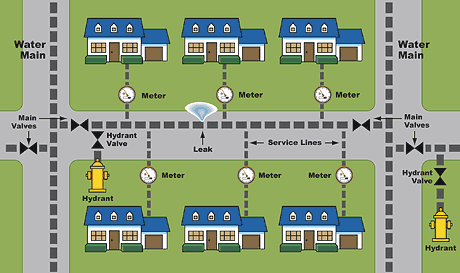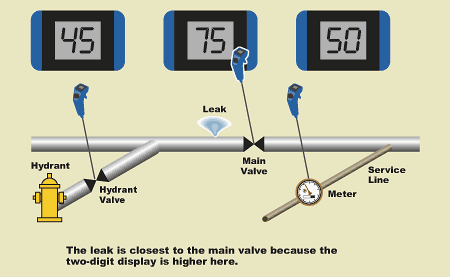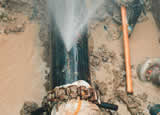 |
The sounds
of leaks in pressurized water pipes can travel for hundreds
(even thousands) of feet in every direction down the mains
and services: |



 |
Different
pipe materials and different pipe diameters transmit leak
sounds down their pipe walls very differently:

| Iron Pipe |
6 inch |
1000 — 1200
ft |
| Iron
Pipe |
12 inch |
800 — 1000
ft |
| Iron
Pipe |
24 inch |
600 — 800
ft |
| AC
Pipe |
6 inch |
800 — 1000
ft |
| AC
Pipe |
12 inch |
700 — 900
ft |
| AC
Pipe |
24 inch |
400 — 600
ft |
| PVC
Pipe |
6 inch |
400 — 600
ft |
| PVC
Pipe |
12 inch |
200 — 300
ft |
| PVC
Pipe |
24 inch |
100— 150
ft |
 |
 |
 |
| *For 5 gal/min leak at 60 psi pressure |
|

 |
The
service line material is also very important when listening
at meters or curb stops:

| Copper Tubing |
600 — 1000
ft |
| Galvanized
Steel Pipe |
800 — 1200
ft |
| “Poly” Plastic
Tubing |
50 — 100
ft |
 |
 |
| *For
a 2 gal/min leak at 50 psi pressure |
|

 |
The leak
survey “strategy” must consider the pipe materials,
pipe diameters, service line materials, and types of leaks
expected. |


 |
If the
distribution system experiences main breaks (5 to 10 gal/min
or more) at certain times of the year and the mains are
iron pipe or A/C pipe, then a “Hydrant Survey” can
be effective and an efficient use of time. Listen at every
hydrant in
every block. If there is no hydrant for 500 ft., then choose
a main valve.
If the
distribution system has PVC mains and copper services,
then an “Every
Meter and Every Valve Survey” may be necessary. Particularly if the
system experiences small leaks at the corp valves (taps into mains). |

 |
If you
hear a leak, listen at the adjacent service lines, hydrants,
and valves. If the sound is louder, then you are closer.
If you cannot tell which one is louder with your ears,
then study the two-digit display: |



HOME | WATER
LEAK DETECTORS | CORRELATORS | LEAK
NOISE LOGGERS | TRAINING | FINDING
LEAKS | WHAT
OUR CUSTOMERS SAY | CONTACT US
© 2016
SubSurface Leak Detection
|





